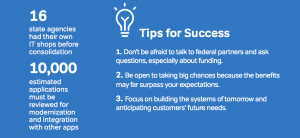This blog post is an excerpt from GovLoop’s recent guide “State and Local Government: 8 Tech Challenges and Solutions.” In it, we provide an overview of case studies from governments across the country. Download the full guide here.
An interview with Matt Vince, Project and Portfolio Director at Louisiana’s Office of Technology Services
Challenge: Consolidating Technology, People and Processes
Matt Vince remembers when IT operations in Louisiana were spread across 16 state agencies.
Each had its own IT shop that ranged in size from three to 100 employees. Because they operated as individual units, it was difficult to have a consolidated approach to technology, let alone implement large-scale modernization projects.
But that started to change in 2014 when state lawmakers created the Office of Technology Services (OTS) to house all IT operations, including personnel, processes, systems, procurement, data centers and project management. Although these operations were consolidated under one roof on paper, the journey to true consolidation is still a work in progress.
Like many state and local enterprises, Louisiana is grappling with various legacy systems. Some are almost 40 years old, and with each comes countless applications.
“All the applications that those agencies support are now things that we need to support,” said Vince, who serves as Project and Portfolio Director at OTS.
One of the primary goals is to improve how employees share and access data to better serve citizens. But there are legal hurdles to overcome.
“Our biggest hurdle so far is just the jurisdictional ownership of some data, [which] makes it very complex and complicated to share,” he said. “While we’ve lowered the technology barrier, we haven’t lowered the administrative legal mine field of federal and state laws that govern some of this data. But where it’s appropriate, we want to be able to share and consolidate and consume it, and that’s where these new platforms come into play.”
Those aren’t the only issues that are top of mind for Vince. OTS uses a cost recovery model to provide IT services to all executive branch agencies. The agency doesn’t have an appropriated budget but instead gets funds by charging its customer agencies for services. Per federal rules, Vince’s agency can charge customers only for the exact cost of the service. In other words, it can’t make a profit.
“The need to be very accurate and very transparent in our costs is our biggest priority,” he said.
Solution
Although Vince and his 850-employee department are still working through the growing pains of consolidation, they are already seeing benefits. In the first year, the department saved $70 million by consolidating personnel and technology and streamlining operations. The department also secured federal funding to help cover the costs of this massive undertaking.
“What consolidation brought is real, true coordination,” Vince said.
That is a big deal because not all agencies are created equal when it comes to funding. Consolidation enables OTS to provide equal services at an enterprise scale that previously could not be done.
For example, the agency is working to provide a set of shared enterprise-level systems and capabilities. They include data management and single sign-on, or the ability to use one login credential to access multiple applications. These are the types of capabilities that can be reused across the state’s public-facing and internal systems, regardless of size or complexity.
“All the new systems will be starting to roll into the single sign-on platform, to where there’s only one account and it’s the single point of entry for everyone, whether you’re a citizen or a worker, or a partner or whatever role you’re playing,” Vince said.
The state is using Splunk to provide a comprehensive machine data platform. That platform enables OTS to better mine data that its systems are already generating, and to readily share that data with its customer agencies.
For example, the agency used to manually pull data from various sources to do billing for its customer agencies. Today that process is automated and done in real time. The benefits extend far beyond nancial data. Having access to current data across various systems enables state officials to make timely decisions and provide better citizen services.
Vince is pleased with the state’s progress but acknowledges there is more work ahead. “The good news now is that we have a vision and a platform to start to really get a lot of new velocity around the modernization effort.”






Leave a Reply
You must be logged in to post a comment.